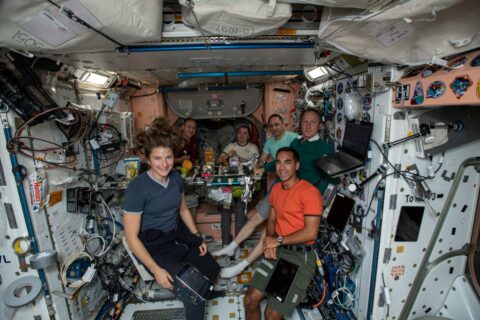Depending on your family and friends, you might be looking forward to a Thanksgiving turkey that’s roasted, smoked, or deep-fried. But what about rehydrated?
For the Expedition 70 astronauts at the International Space Station, orbiting 250 miles above Earth in space, the meal will likely include pouches of poultry, which, when prepared, may or may not remind you a little of those Fancy Feast cat food commercials.
NASA sent up the cosmic culinary delights, along with about 6,500 pounds of other supplies, on an uncrewed SpaceX Dragon spacecraft on Nov. 9. It launched from Kennedy Space Center in Cape Canaveral, Florida, and docked at the humongous space laboratory two days later.
So what’s on the menu for the upcoming holiday feast?
The U.S. space agency shipped a fresh food kit that included oranges, apples, cherry tomatoes, and carrots. But for appetizers, the astronauts might want to start off with the two specialty cheese kits that offer a smorgasbord of fromage. That’s not all, said Dana Weigel, NASA’s deputy manager for the space station.
“Because we’re in the holiday season, we’ve got some fun holiday treats for the crew,” she said during a pre-launch news conference, “like chocolate, pumpkin spice cappuccinos, rice cakes, turkey, duck, quail, seafood, cranberry sauce, and mochi.”
You read that right: From Starbucks to the stars, ’tis the season to indulge in pumpkin spice obsessions. The crew even has a special sci-fi space cup for drinking them.
Want more science and tech news delivered straight to your inbox? Sign up for Mashable’s Light Speed newsletter today.
The astronauts could also make pizzas or nosh on hummus, salsa, and olives.
If your mouth is watering, wait ’til you see how the turkey actually gets made. In the video below, astronauts demonstrate how a package of turkey tetrazzini is prepared at the space station. A pouch is attached to a machine that fills dehydrated food with hot water. The pouch is set aside to fully absorb the water, then it’s cut open to eat.
Expedition 70, which began Sept. 27, includes European Space Agency Commander Andreas Mogensen and NASA flight engineers Jasmin Moghbeli and Loral O’Hara. Cosmonauts Konstantin Borisov, Oleg Kononenko, and Nikolai Chub, and Japan Aerospace Exploration Agency astronaut Satoshi Furukawa, also join them. They will be aboard the station until the spring, studying microgravity and researching heart health, cancer treatments, and space manufacturing techniques.
The first Thanksgiving in space happened on Nov. 22, 1973. Skylab 4 astronauts Gerald P. Carr, Edward G. Gibson, and William R. Pogue had only been in space for a week when the holiday occurred. Gibson and Pogue completed a nearly seven-hour spacewalk, while Carr remained in the Multiple Docking Adaptor with no access to food, according to NASA. All three had to skip lunch, so they scarfed down two meals at dinner. Neither helping included any special holiday foods.
The Expedition 1 crew — William M. Shepherd, Yuri P. Gidzenko, and Sergei K. Krikalev — was the first to have Thanksgiving aboard the ISS in 2000, eating ham and smoked turkey. Ever since, astronauts have celebrated Thanksgiving in space. Over time, the meals got a little more elaborate, incorporating mashed potatoes, green beans, and blueberry-cherry cobbler.

Expedition 66 crew members eat a Thanksgiving meal inside the International Space Station.
Credit: NASA Johnson Space Center
Space food has come a long way over the past 60 years of spaceflight. Astronaut John Glenn was the first to prove that swallowing and digestion were possible in a weightless environment. Mercury astronauts ate tubes of puree and cubes of dry goods. During the Gemini missions, freeze-dried food and powdered beverages entered circulation. With the Apollo moon program came the ability to rehydrate and warm food with hot water.
There’s a lot more to space food than astronaut ice cream — that’s the famous frozen treat put into a vacuum chamber and heated to evaporate the water, directly converting the ice to a gas. The process continues until all of the water content is removed. Freeze-dried food has other benefits, such as reducing the weight of the food for shipment and preserving the nutrition.
But it’s not as appetizing as eating ice cream — or pretty much anything else — on Earth. So on this Thanksgiving, you can think of the astronauts and thank your lucky stars for ovens, stoves, crumbly bread, saucy sauces, and brimming gravy boats.
Topics
NASA
